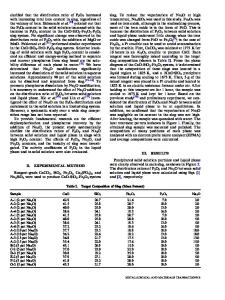A Thermodynamic Model of Phosphorus Distribution Ratio between CaO-SiO 2 -MgO-FeO-Fe 2 O 3 -MnO-Al 2 O 3 -P 2 O 5 Slags
- PDF / 1,213,632 Bytes
- 33 Pages / 593.972 x 792 pts Page_size
- 2 Downloads / 345 Views
arch Professor, is with the State Key Laboratory of Multiphase Complex Systems, Institute of Process Engineering, Chinese Academy of Sciences, Beijing 100190, P. R. China. Contact e-mail: [email protected] JIAN-PING DUAN, Senior Engineer, and YONG-LIANG ZHANG and JIANCHANG WANG, Engineers, are with the Technology Center, Shanxi Taigang Stainless Corporation Limited, Taiyuan 030003, P. R. China. CHENG-BIN SHI, Ph.D. Candidate and Joint-Training Student, is with the School of Metallurgical and Ecological Engineering, University of Science and Technology Beijing, Beijing 100083, P. R. China, and with the Institute of Process Engineering, Chinese Academy of Sciences. MENG ZHANG, Master Degree Student and Joint-Training Student, is with the School of Metallurgical and Ecological Engineering, University of Science and Technology Beijing, and with the Institute of Process Engineering, Chinese Academy of Sciences. Manuscript submitted October 20, 2010. Article published online April 21, 2011. 738—VOLUME 42B, AUGUST 2011
INTRODUCTION
NOT only the blast furnace ironmaking process but also most common secondary refining processes have limited dephosphorization ability. Therefore, the dephosphorization operation in both the hot meat pretreatment and the converter steelmaking process is very important to fulfill the requirement of phosphorus content for molten steel in the routine metallurgical process. Compared with the dephosphorization operation in hot metal pretreatment, phosphorus extraction in converter steelmaking process is almost the final dephosphorization operation. Hence, improving dephosphorization ability in the converter steelmaking process is very important to control the phosphorus content in the aimed specification of molten steel. METALLURGICAL AND MATERIALS TRANSACTIONS B
As an important function of converter steelmaking process, the oxidizing dephosphorization of hot metal or molten steel, has been investigated by many researchers[1–19] since the 1940s,[1,2,9] and many phosphorous distribution ratio prediction models[9–16] have been developed based on some empirical regressions of the measured data, such as Healy’s model,[10] Suito’s three models,[11,12] Sommerville’s model,[9,13] and Balajiva’s model.[14] However, the phosphorous distribution ratio models[9–16] are not enough and scarce from the view point of dephosphorization reactions based on metallurgical physicochemistry. Zhang[20] has developed some thermodynamic models for predicting the phosphorous distribution ratio LP of FeO-Fe2O3-P2O5, MgO-FeO-Fe2O3-P2O5, CaO-MgOCaO-SiO2-MgO-FeO-Fe2O3-P2O5, FeO-Fe2O3-P2O5, CaO-SiO2-MgO-FeO-Fe2O3-MnO-P2O5, and CaO-SiO2MgO-Na2O-FeO-Fe2O3-MnO-P2O5 slags equilibrated with hot metal from the view point of dephosphorization reactions based on the ion and molecule coexistence theory (IMCT).[20–25] The results of the developed phosphorous distribution ratio prediction models by Zhang[20] show that the predicated LP from the developed models[20] based on IMCT[20–25] have good agreement with the measured LP for the pr
Data Loading...










